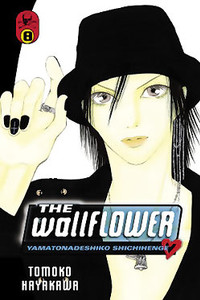Review
by Carl Kimlinger,The Wallflower
G.novel 8
| Synopsis: |  |
||
If the four über-bishounen tasked with reforming über-creepy Sunako are actually doing anything to further their quest, it certainly doesn't show. Takenaga is preoccupied with his relationship with his sort-of girlfriend Noi, and everyone else is content to contain Sunako's abnormal behavior and unhealthy influence (which this outing covers curbing the growth of her macabre collection, and stopping her from digging up corpses). They even accommodate her, getting jobs to relieve the strain on her when it becomes obvious that their dependence on her is adversely affecting her already tenuous mental stability. Will they ever succeed in turning her into a lady? If the effort they put forth in this volume is any indicator, then no. |
|||
| Review: | |||
The quality of any given chapter of Wallflower is inversely proportional to the amount of time Sunako spends in her super-deformed state. The more she is actually drawn, the better the story. The reason for this is simple: she's the only reason to read this manga in the first place. After a hugely disappointing seventh installation, volume 8 drags Sunako back into the spotlight, and in the process drags itself from the hole it dug in the previous volume. Unlike its predecessor, the chapters in this volume all have some reason for existing. The first chapter adds a few splashes of color to Takenaga's previously monochrome personality by putting the screws to his relationship with Noi. For once, his character actually elicits mild interest, particularly when, at the depths of his depression, he begins to associate heavily with Sunako's "friends". The second story showcases Sunako's softer side, when the boys discover her relationship with a feisty old granny whose tastes correspond with Sunako's to a frightening degree. This chapter also features a fantastic fishing contest during which Sunako lapses into SD mode only occasionally. The third chapter has no character building, plot advancement or any of the traditional qualities associated with good story-telling, but it does feature the joyous return of Sunako's Waffen SS uniform, which makes it indispensable (what can I say? I'm in love). The final chapter showcases the comfortable dynamic that has developed at the boarding house by briefly destroying it, and focusing on the effects of the falling-out and the lengths both sides go to to rectify the situation. The high point of this chapter is a humorous montage that reveals Sunako's antidote to the foursome's brightening influence. All is not well with the manga, however. For one, the lack of a continuous story limits the manga to light entertainment. The honest-to-goodness darkness of the opening volumes has yet to return, especially where Sunako is concerned. She has become so well balanced (relative to her previous psychosis) that she is positively benevolent in these chapters, although her corpse-raiding visit to the cherry trees in her SS uniform does recall some of her more bizarre earlier behavior (now, if only she'd use her chainsaw a little more often). With stories this light, there is also no room for her awe-inspiring outbursts of righteous violence, draining the impact of her behavior. And then there's the art. Tomoko Hayakawa's art is best described as lazy. Her backgrounds are, well, not there. Blank. Zero. Nada. Nothing. She doesn't even bother with establishing settings much of the time, making scene transitions quite confusing. Background characters are either indistinguishable from one another, or drawn with all of the detail of smiley faces (sometimes less, at least smiley faces have noses and eyes). Sunako is still an ill-defined, eyeless blob most of the time, and even the four boys are often drawn in some simplified form or another. Of course, the hormone-driven author expends the majority of her energy on drawing her bishounen, and, as always, audiences will be split between those whose breath is stolen away, and those who get the willies (the scene of Ranmaru showering epitomizes this trend). Hayakawa does pull out the stops for something other than pretty boys on occasion. Takenaga and Noi's reconciliation is visually impressive, and Sunako gets several chances to show off just how cool she really is. There's a scene where she messily eviscerates a tuna, the fishing contest in which she fishes while wearing a buckles-and-cinches dress, high-heeled boots and fishnet stockings, and a stunning panel in which Sunako makes a bold proclamation ("I love corpses") while silhouetted against the full moon in her SS uniform. It's not like Hayakawa can't draw, it's just that most of the time, she chooses not to. Presentation is fine overall. Sound effects are left in the original Japanese, with unobtrusive translations nearby. Del Rey's "special extras" are Hayakawa's usual updates on her concert-going activities, but also include an explanation by the author of an editing mistake/censorship issue in the original Japanese printing of volume 7 (worry not, the English volume 7 was taken from the corrected Japanese volume). Del Rey's ever-welcome translation notes and next-volume preview also crop up at the end of the book. It can't exactly be called a return to form—the art is too lackluster and the plot too light and inconsequential to justify that claim—but the eighth volume of Wallflower, with its greater focus on Sunako and some minor character-building, is definitely a step in the right direction. |
| Grade: | |||
|
Overall : B-
Story : C+
Art : C
+ More fun than it should be, Sunako makes a comeback, and the SS uniform returns. |
|||
| Production Info: | ||
|
Full encyclopedia details about Release information about |
||